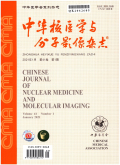不同参考脑区对阿尔茨海默病 18F-Florzolotau PET图像SUV比值的影响
Effects of different reference brain regions on the SUV ratio of 18F-Florzolotau PET images in Alzheimer′s disease
摘要目的:比较不同参考脑区对阿尔茨海默病(AD) 18F-Florzolotau PET图像SUV比值(SUVR)的影响。 方法:从复旦大学附属华山医院收集2018年11月至2020年7月间正常对照(NC)28名[男13名,女15名,年龄(57.3±9.5)岁]、β淀粉样蛋白(Aβ)阳性的轻度认知障碍(MCI)患者19例[男4例,女15例,年龄(73.3±7.3)岁]和AD患者40例[男19例,女21例,年龄(61.9±9.1)岁]的 18F-Florzolotau PET图像。定义6种参考脑区:全小脑(WC)、小脑灰质(GM)、小脑白质(WM)、参考信号强度的参数化估计(PERSI)、部分容积校正(PVC)后的WC(WC_pvc)、PVC后的小脑GM(GM_pvc),分别计算14个ROI[由自动解剖标记(AAL)模板定义的全脑,由AAL模板定义的梭状回、颞下回、舌回、颞中回、枕叶、海马旁回、顶叶、后扣带回、楔前叶以及上述脑区构成的Meta ROI,由Desikan Killiany模板定义的braak_Ⅰ~Ⅱ、braak_Ⅲ~Ⅳ、braak_Ⅴ~Ⅵ]的SUVR,用AUC衡量SUVR对疾病组与NC的分类能力,并评估SUVR与临床量表评分的相关性(Spearman秩相关分析)。 结果:大部分脑区的SUVR在AD疾病谱中表现出稳定的上升趋势。在NC与MCI的分类中,基于WC_pvc的SUVR整体表现相对最优(AUCs:0.975~1.000);在NC与AD的分类中,10个脑区SUVR在WC_pvc方法下效能最优(AUCs:0.976~1.000)。基于小脑WM的梭状回SUVR表现出与简易精神状态检查量表(MMSE)评分最高的相关性( rs=-0.72, P<0.001);基于WC_pvc的楔前叶SUVR表现出与临床痴呆评定量表(CDR)评分最高的相关性( rs=0.78, P<0.001)。 结论:基于WC_pvc的SUVR在AD疾病鉴别、相关性分析等任务中获得了较好的效能,推荐将其用于AD 18F-Florzolotau PET图像半定量分析。
更多相关知识
abstractsObjective:To compare the effects of different reference brain regions on the semi-quantitative SUV ratio (SUVR) of 18F-Florzolotau PET images of Alzheimer′s disease (AD). Methods:The 18F-Florzolotau PET images of 28 (13 males, 15 females, age (57.3±9.5) years) normal controls (NC), 19 patients (4 males, 15 females, age (73.3±7.3) years) with β-amyloid (Aβ)-positive mild cognitive impairment (MCI) and 40 patients (19 males, 21 females, age (61.9±9.1) years) with AD were collected from Huashan Hospital, Fudan University between November 2018 and July 2020. Six semi-quantitative reference brain regions were defined, including whole cerebellum (WC), cerebellar gray matter (GM), cerebellar white matter (WM), parametric estimation of reference signal intensity (PERSI), WC after partial volume correction (WC_pvc), cerebellar GM after partial volume correction (GM_pvc). SUVR was calculated for 14 ROIs, which included the whole brain defined by the automated anatomical labeling (AAL) template, fusiform, inferior temporal, lingual, middle temporal, occipital, parahippocampal, parietal, posterior cingulate, precuneus defined by the AAL template, and Meta ROI composed of the above brain regions, and braak_Ⅰ-Ⅱ, braak_Ⅲ-Ⅳ, braak_Ⅴ-Ⅵ defined by the Desikan Killiany template. AUC was used to evaluate the classification ability of SUVR, and the correlation between SUVR and clinical scale scores were assessed by Spearman rank correlation analysis. Results:The SUVRs of most brain regions showed a steady upward trend in the AD disease spectrum. In the classification task of NC and MCI, the overall performance of SUVR based on WC_pvc was relatively optimal (AUCs: 0.975-1.000). In the classification task of NC and AD, SUVRs of 10 ROIs based on the WC_pvc method showed the relatively best performance (AUCs: 0.976-1.000). The correlation between SUVR of fusiform based on cerebellar WM and mini-mental state examination (MMSE) score was the strongest ( rs=-0.72, P<0.001), and the SUVR of precuneus based on WC_pvc showed the strongest correlation with clinical dementia rating (CDR) score ( rs=0.78, P<0.001). Conclusion:The SUVR based on WC_pvc method performs well in classification and correlation tasks, and is recommended to be used in semi-quantification of 18F-Florzolotau PET images of AD.
More相关知识
- 浏览0
- 被引2
- 下载0


相似文献
- 中文期刊
- 外文期刊
- 学位论文
- 会议论文



 换一批
换一批 换一批
换一批



